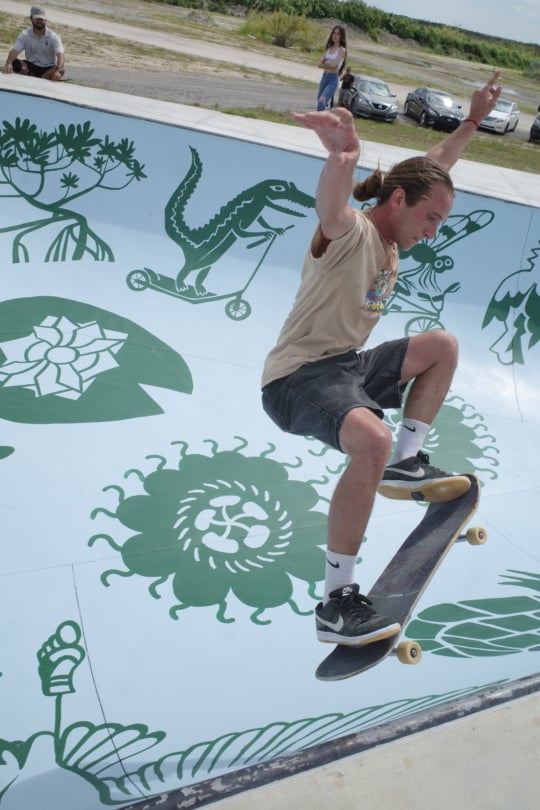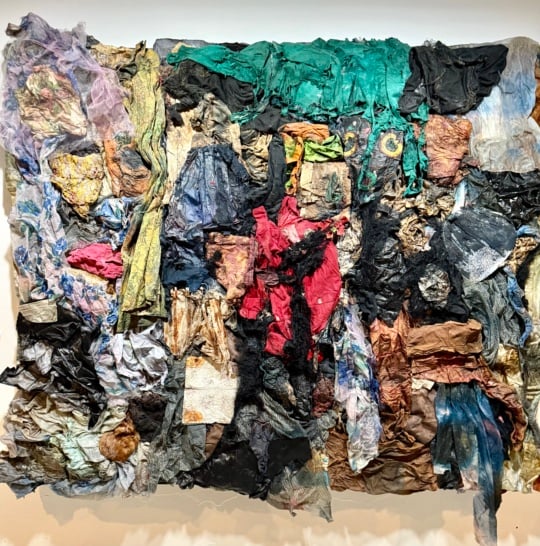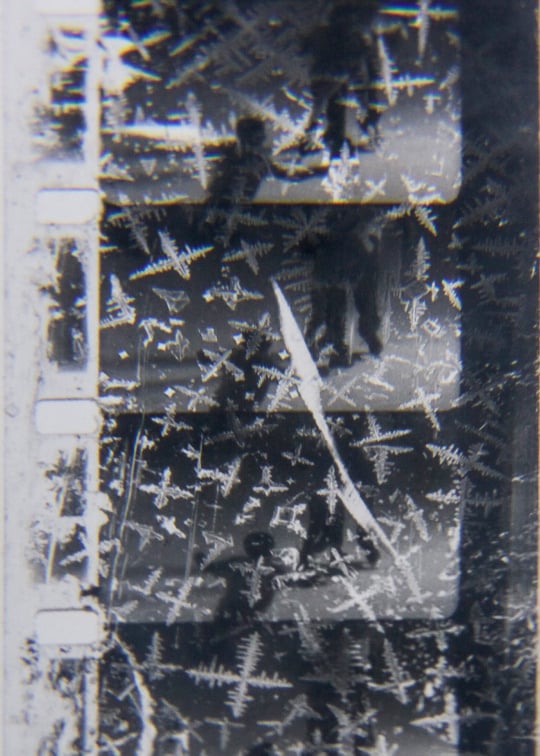
Whenever I run into the artist Jordan Stubbs (which is, pleasingly, often), I’m never disappointed by the novelty and enthusiasm of his greetings. Sometimes I receive mock-formal salutations accompanied by palms pressed together and a bow of the head; more often it’s a folksy “Howdy-do!” and a hug. Like many others, I first met Stubbs when he was part of the audacious team behind the Old Fourth Ward’s Low Museum, which closed in May. By that time Stubbs was over halfway through his yearlong residency as a Mint Leap Year Fellow and working as a gallery assistant at the Swan Coach House Gallery. As disappointed as I was to see the Low go, I was also eager to see what Stubbs—along with his co-founders Pastiche Lumumba and Theodore McLee—would get up to in the wake of the museum’s closing.
I spoke with Stubbs at his Goat Farm studio earlier this month about preparing for “TOO MUCH AT ONCE? New works from Jordan Stubbs to you,” his Mint Leap Year solo exhibition on view at Downtown’s Flatiron Building through November 5. Throughout our conversation Stubbs alternated between animated expressiveness and quiet rumination, occasionally doubling back on something he’d said to offer qualification or detail.
LL: How did you get involved with the Low Museum, and what role did that play in your development as an artist?
JS: I had been living with Theo and Lumumba with another roommate in Reynoldstown, but when she moved out the three of us moved into the Low together. It wasn’t the Low then, it was just this weird-ass triplex Lumumba found on Craigslist. He was a genius and brought the deposit in cash, so we just got the house. We moved in in June, and I think our first show was in July. It was just a matter of painting the walls.
LL: When you all moved did you know you wanted to operate a space like that?

JS: There were talks of even doing a show at our shitty house in Reynoldstown before we moved out. It was definitely on Lumumba’s mind. He certainly took the lead with the first show, and in the second one I put some of my photos on the wall. It all started very casually. It was also the place where I had my political awakening. I learned a lot from Theo and Lumumba and the discussions that occurred in that space, and I regret not participating in more of them at the time. I think Atlanta was just so ready for something like that and we were just swept up in it. And it certainly launched me into Leap Year. Sarah Higgins, the curator at the Zuckerman, visited me yesterday, and she said she had heard about the Low before she moved here, and I was just like, “What?” I loved having a space and I really loved arranging shows. I still don’t think I’m quite a curator. I never solely curated a show at the Low; I was only ever part of the crew, but I always wanted to have a say as to where things went in the space.
LL: What was your training at GSU?
JS: I got my BFA in photography in 2014.
LL: Is that primarily what you’d been doing before going to college?
JS: My first real art class was in college. Even though I’m not doing any photography any more, I feel like I learned to ask myself why in a way that other art programs at State maybe don’t do. Because, you know, if you’re a sculptor or painter, there’s a lot more material knowledge that you acquire before a concept can enter it—not necessarily, but usually. And with photography, beyond dark room processes or something, there really wasn’t too much of a material hurdle to get over. I bring that mentality and framework to everything else I’m doing now. I got very tired of being so hands-off and far away from my ideas, and I didn’t live the pristine lifestyle that photography requires. I got really bogged down and hated if a picture got wrinkled or something, the illusion is broken, the photo’s ruined, try again. It just didn’t click well. I know I’ll eventually end up doing it again in some form. When I figure out how to fuck with that expectation, that’s when I’ll come back to it. For now, I want to get my hands on stuff.

LL: When did you begin departing from more photo-based work? Was that within the program, while you were still at State?
JS: During my last year, my portfolio project was about iPhones and Sherry Turkle’s idea about being “alone together” because of technology. I got really interested in how iPhones were shaping our bodies, like the idea of the selfie arm as this separate zombielike thing. My final install at State included two big framed prints of a scanned cracked iPhone screen.When I was framing one of them, the glass cracked too, and I was like, “I can’t even be mad,” you know? [laughs] In that program, if you can say why, they won’t make you keep taking photos. I’m not the only person who’s expanded outside of photography within the program.
LL: I wanted to touch again on what you were saying about these expectations about the pristine nature of photography as a medium, because your work has elements of playfulness and casual approachability that subvert the way viewers interact with the artwork. The wall text for your zip-tie piece at this year’s Art Papers auction included the words “Please touch!” at the bottom. You’re using unconventional materials but also changing the viewer’s relationship to the object.

JS: I definitely am attracted to not using traditional art materials. It all kind of starts there. I feel like there’s a lack of preciousness to a lot of my work. I like working with objects that feel familiar in a way. An object or material has a conventional purpose but it also has material qualities outside of that purpose, and I ask how I can exploit those. I try to not see what it’s supposed to be used for but instead what it’s made of.
LL: That reminds me of the video you did for “Scenes of Disproportion” with the corrugated metal sheet. What you were doing with the metal sheet—causing it to shimmer and rumble as you moved around inside—was much more interesting to me than identifying what it was.
JS: I like that: what it can do trumps what it is. I see something and I’m like, “Wow! This is great already.” And then I take it, and I look at it and live with it for a while and do other things around it. I still haven’t reconciled this, but I can’t just be the artist who finds a cool thing and that’s it. I still want to have my hand in it in some way. Yesterday, Sarah [Higgins] said that, in a lot of the pieces, you couldn’t quite tell how it was found versus what I did to it, and I was like, “That’s where I’m trying to be.” I get things without knowing what I’ll do with them. I have ways of working where I introduce new materials—right now it’s zip ties and drywall mud—and I know to do something with these things, but I want to expand that. I’m very unskilled right now. I can use rudimentary power tools, but I don’t really know anything else.

LL: There’s a sort of revelry in that, being unskilled, but it’s so thoughtful at the same time.
JS: I’m very unskilled and I can be insecure about it if I want to be. I think I use time, spending lots of time on a process—it’s definitely not the quickest way to do it—as kind of my armor. Of course people spend a lot of time on bad things, or things that I would say are bad, but I don’t feel that way about what I’m doing. It becomes very meditative. Painting these pieces of wood is not hard, and cutting that drywall is tedious.
LL: You treat your materials like objects you can learn from. Sarah’s comment is really about the lightness of your touch.

JS: I like to think about how I adorn garbage. I see something that’s been tossed, I give it attention, and I spend time with it. I can’t help but personify everything too; I’m a very empathic and emphatic person. I’ll look at something and imagine what range of emotions it could feel, or what emotions are tied up in its form or material, and also how I feel or what I’m going through. How do I pump that through it? Or how do we meet, me and the object? I’d love to get to a point where something new comes out of it, but right now I feel like I’m pushing my emotions through the object. But I also use what’s there, exploit that, like knowing I could cut the drywall to make the word SURE out of this building material that’s supposed to stay sure of itself.
LL: The word “sure” has a beautiful double meaning—it means certainty but it’s also ironic, adolescent, dismissive.
JS: Very flippant and noncommittal. I love words and wordplay as a starting point too. I feel like at some point I’m going to make up my own almost-language, because I’ll constantly just say a phrase in my head and kind of break it down. That’s like the truth, I live in that, whatever that is, and I’d love to keep developing that. I’d love to be like a text-based sculptor. You saw my WELL piece at the Mint Leap Year Applicant Exhibition, right? It was the FUZZY FEELINGS piece with zip ties spelling out “well,” hanging on a PVC pipe stuck into the wall. I still really love that piece.

LL: “Well” is sort of like “sure” too. Their double meaning allows a sort of conceptual, abstract wordplay that’s similar to what Bethany Collins does in her Contronym series. Contronyms are like homonyms that also contain their opposites, like “ravel” is to complicate something but it’s also to undo it. But “well” and “sure” are not like “ravel”—they’re so plainspoken, and that’s part of the charm. It’s conceptual wordplay that also has a colloquial quality.
JS: I like that too. I’m comfortable being pedestrian in a certain way. I’ve thought about that a lot. When I was first working at Swan and didn’t have a car, I would walk from the Low to Peachtree Center, then take a 10 minute MARTA ride, and then walk another mile and a half down Peachtree. There was just constantly construction, and I told myself I had to be an aggressive pedestrian because I had the right of way. One of my original show titles was actually “Pedestrian Static,” because I like the wordplay there. Like a static pedestrian: someone who’s just, what, loitering? Standing there?
LL: Taking up space?

JS: Yeah, exactly. Originally I thought my imagery for this show would be road signs. When you’re walking around the city, what do these signs mean when you’re not in a car? My show title now is “TOO MUCH AT ONCE?” I’ve always been obsessed with standards, like am I being too this or not enough this in a situation. All of the anxiety that’s pumped into this work is based on financial instability and feeling pulled in a lot of different directions, but then also being unsure about those feelings. That’s where the question mark enters the title, not even really knowing if it is too much at once or not. You have to wonder and kind of make decisions blindly, or ride out your feelings.
At Georgia State one of the ideas I thought I was going to work with over the portfolio period was the simultaneous inside-your-brain world and you-out-in-the-world world, and how there can just be a big ol’ split between the two. But I never found the way to get at that photographically. As I was walking to work a lot, I drew this metaphor between construction in the city and a quest for self-improvement. There are similarities there. You can’t shut the street down because people still have to use it, so you have to detour, divert, reallocate. Things change but have to keep moving. There’s a limited amount of resources and time. There’s a history: what are you tearing down, and what’s getting built? That became my new language for inside and outside the brain, and that’s kind of what tied me to construction materials for a while.
LL: I’ve always wondered about your affinity for construction materials, which I’ve also heard you describe as “home improvement” materials before, which works with this metaphor relating construction and self-improvement. Just by engaging with the imagery of construction sites or home improvement, you’ve also sort of automatically tapped into the imagery of danger and safety, which shows up in the bright colors, for example. And even though you’ve said you’ve moved on from street signs, these shutters still have the chevron pattern we associate with signs.

JS: The ideas are less overt than I thought they were going to be at first. Something else I like about signs is that they’re very context oriented. What does a sign mean once it’s fallen over, or the “Open” sign that’s left on all night even though the store is closed? But I also think about how many miles of orange cones you see on the highway and how invisible those become too—they’re ubiquitous but invisible. How do I assign emotions to that? How do I get you to come closer to something that’s supposed to keep you away? Danger and safety, both at the same time.
LL: You said you wanted to do the show title in all caps, which you’ve often used to title your work. Where does that come from?
JS: Yeah, I don’t know when that started. I guess it was with YOUTELLME, which was almost two years ago at the Low. I don’t know. I like the desperation in it. I don’t mind if it’s interpreted as yelling. I feel like all of my titles are like, “Please!” in a way. I think it make sense if you know me.
“TOO MUCH AT ONCE?: New works from Jordan Stubbs to you” is on view at the Flatiron Building through November 5. Stubbs will give an artist talk on Saturday, October 29 at 4 pm.
Logan Lockner is Assistant Editor of BURNAWAY.




